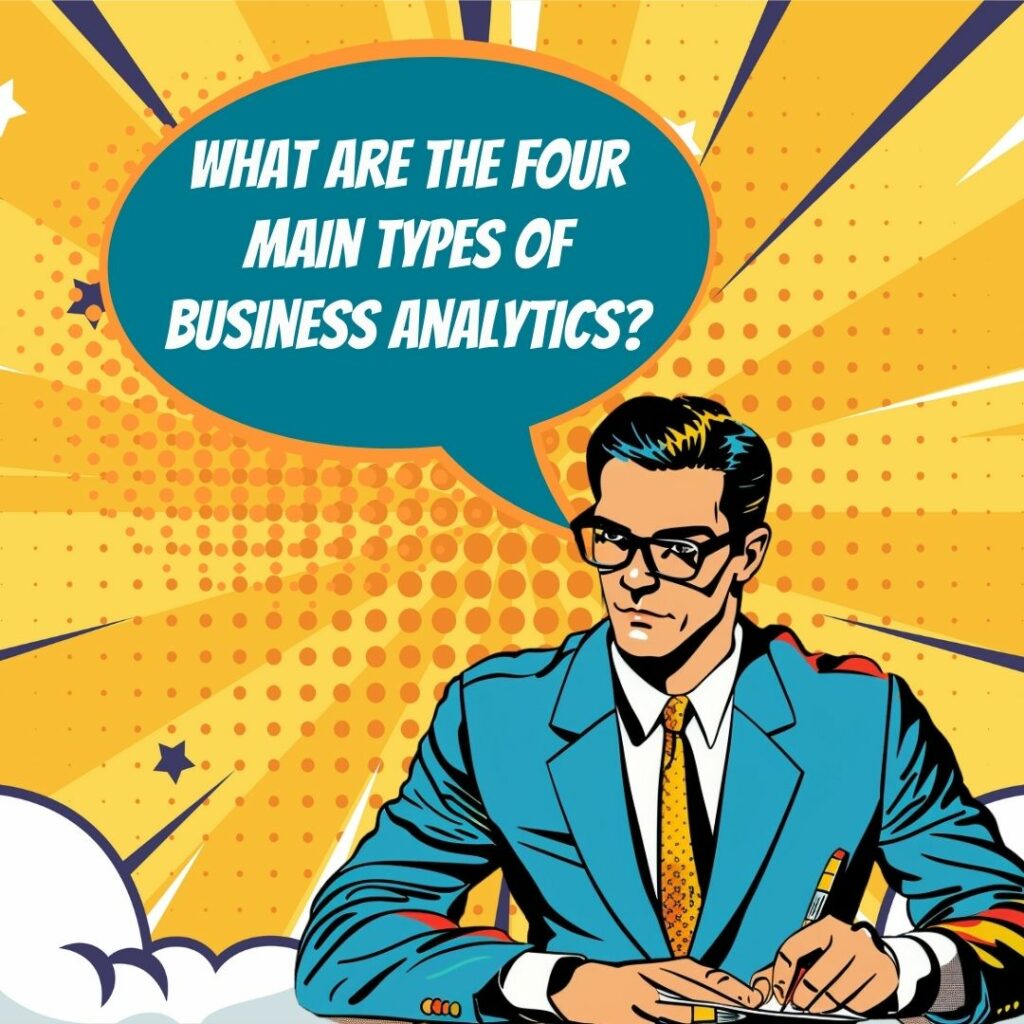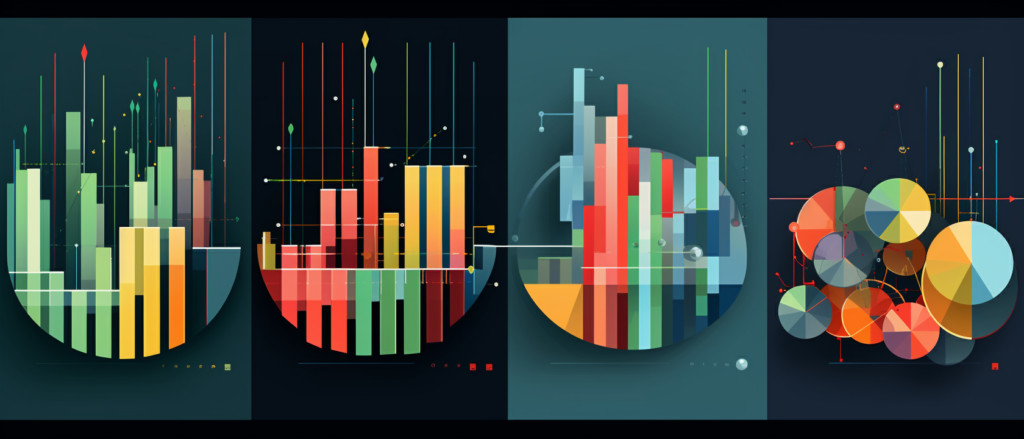Key Takeaways
✅ Descriptive Analytics lays the foundation by summarizing historical data, giving a clear view of past performance. Imagine looking at snapshots of business activity that highlight your peaks and troughs. Now, with this intel, you can start to see patterns you might have missed before.
✅ Diagnostic Analytics takes you on a detective journey, examining the ‘whys’ behind your business outcomes. It’s like having a magic magnifying glass that shows the reasons behind every success or hiccup. What changed, and how did it affect your bottom line?
✅ Predictive Analytics is the crystal ball of the business world, using data to forecast what could happen next. If you knew what’s likely going to sizzle and what’s going to fizzle, how would you prepare differently?
✅ Prescriptive Analytics isn’t just about looking ahead; it’s about taking charge. It’s like having a trusted advisor in your corner, suggesting the smartest moves to outwit the competition and satisfy customers. Ready to play the game with the best strategy in hand?

Introduction
Ever pondered over the mystery of why some businesses seem to almost magically know the next best move? Well, the secret isn’t in a crystal ball; it’s in understanding the powerful Four Types of Business Analytics. Now, you might feel a bit wary about diving into the world of data analytics. Is it all just a bunch of charts and numbers that sit in reports nobody reads? No way! Imagine having the keys to a treasure chest that holds the secrets to your business’s successes, and yes, even its flops.
Whether you’re a seasoned pro stepping up your game, or a newbie just dipping your toes in the data pool, knowing how to navigate these waters can make a remarkable difference in your journey. This article isn’t just going to rattle off definitions. It’s about opening your eyes to a new way of thinking, a strategic compass that’ll point you toward more informed decisions and, ultimately, to greater heights in revenue, ROAS, and ROI. Sounds like a game-changer, right?
Buckle up, because we’re about to embark on a journey through the realm of descriptive, diagnostic, predictive, and prescriptive analytics. Along the way, I’ll show you how these analytics aren’t just for impressing with jargon at meetings, but they are real tools that can pave your path to success. Stick with us and you’ll soon unlock actionable insights and groundbreaking information that could revolutionize the way you do business.
Top Statistics
| Statistic | Insight |
|---|---|
| Global Market Size for BI and Analytics: Estimated at $35.7 billion in 2021. (Source: Statista) | This robust market size highlights the ubiquitous nature of descriptive analytics in enterprises worldwide, reflecting its foundational role in business understanding. |
| Enterprises Using Descriptive Analytics: 94% as per a 2020 survey. (Source: MicroStrategy) | Nearly all businesses are leaning into descriptive analytics. It’s clear they’re eager to back their choices with solid data on past performance. |
| Focus on Real-Time Data in Analytics: 50% of new investments by 2025. (Source: Gartner) | The future is now, and it’s all about speed. Organizations are not just looking to predict the future; they want to shape it in real-time. |
| Prescriptive Analytics Market Growth: From $1.7 billion in 2020 to $5.4 billion by 2025. (Source: MarketsandMarkets) | This aggressive growth signals a shift towards advanced, actionable insights. Are businesses ready to not just predict but also prescribe the future? |
| Organizations Deploying Prescriptive Analytics: Only 17% have deployed, 38% planning within two years. (Source: TDWI) | While still emerging, prescriptive analytics is on the rise. It’s about time businesses asked themselves – Are they ready to take this step into actionable foresight? |
The Four Crucial Analytics Techniques
1. Descriptive Analytics: The Story of Your Data
Have you ever sifted through your old photos and reminisced about the good times? Descriptive analytics works similarly for businesses; it’s like the group picture of data. It breaks down sales numbers, customer interactions, and website traffic into visuals that are easy to digest. Think about getting a snapshot of your business’s performance over the past year – were there any hotspots when sales jumped? Maybe holiday seasons or special events? This analytics type is a treasure chest, offering up the story of ‘what happened,’ turning raw data into bite-sized, actionable insights.
2. Diagnostic Analytics: The Sleuth Work Behind the Scenes
So your business had a sudden drop in sales one month. You’re probably scratching your head, asking, “What went wrong?” Diagnostic analytics puts on its detective hat to find out. Using data comparisons and drilling down to specifics can uncover that maybe it was due to a local road construction or a hiccup with the payment provider. It’s about connecting the dots between action and reaction within your data, shining a light on the ‘why’ behind the scenes. Do certain products sell better on sunny days, or do more people visit your website after a community event? This analytics tool helps you spot those patterns.
3. Predictive Analytics: Your Crystal Ball for Future Success
Imagine if you could tap into tomorrow’s headlines today. With predictive analytics, you’re almost doing just that, but for your business. It’s like having a crystal ball that uses your past data to make educated guesses about the future. Algorithms and models work around the clock to forecast trends — like customer demand or inventory needs. Whether it’s pinpointing the next big product or foreseeing a dip in sales, this tool helps you prepare for the future, not just react to it. Imagine knowing beforehand which days will be your busiest so you can staff up and stock up accordingly.
4. Prescriptive Analytics: Crafting Your Path Forward
Now let’s talk about turning those predictions into plans. Prescriptive analytics is the strategist in the room, rolling up its sleeves to give you concrete steps for the road ahead. It doesn’t just predict; it prescribes. By analyzing the data and considering multiple scenarios, it outlines possible outcomes based on different paths you could take. Perhaps it means adjusting your marketing spend, tweaking your prices, or even revamping your product offerings. How could you make customer experiences even smoother or customer service more efficient? Prescriptive analytics is your guide to making those choices with confidence.
Synergy of Analytics Types: Crafting The Strategy
Imagine all these analytics types as tools in your shed. You can use each on its own, sure, but when you use them together, they become even more powerful. It’s about integrating insights from descriptive and diagnostic analytics to fine-tune your predictive models, which then inform your prescriptive tactics. Maybe it’s discovering that offering a new service could skyrocket your regulars, or adjusting your opening hours could tap into an unmet customer need. This synergy doesn’t just solve problems; it opens up entirely new opportunities.
You don’t have to pick just one analytics type. In fact, they work best when mixed together. Imagine using descriptive analytics to spot your best month, diagnostic to uncover the reason, predictive to forecast the next big hit, and prescriptive to tailor your marketing campaign. Integrated analytics isn’t just about piling up data—it’s about weaving it into a story that guides you to smart decisions. And isn’t that the kind of data-powered fairytale all businesses dream of?
AI Marketing Engineers Recommendation
Recommendation 1: Leverage Descriptive Analytics to Improve Customer Engagement: With the increasing amounts of data created every minute, it’s crucial to understand what’s happening in your business right now. Descriptive Analytics offers a look at your past performance and gives insights into customer behavior. To make this actionable, regularly monitor your sales, website traffic, and engagement metrics to identify trends. Have you noticed more website visits after a recent campaign? Did your engagement increase after a product launch? Use this data to tailor your marketing efforts – if something’s working, do more of it; if it’s not, pivot quickly.
Recommendation 2: Embrace Predictive Analytics for Forecasting and Risk Assessment: Current trends show a surge in businesses using AI and machine learning to predict future outcomes. Predictive analytics can give you an edge in the market by forecasting sales trends, customer behaviors, and market dynamics. Start by collecting and analyzing historical data to create predictive models. Then test these models against current trends and adjust accordingly. Often afraid your new product might not hit the mark? Predictive analytics can reduce that fear by providing a data-backed forecast.
Recommendation 3: Implement Prescriptive Analytics to Enhance Decision Making: In an era where data-driven decisions are paramount, Prescriptive Analytics can be the crystal ball for your strategy. It goes beyond predicting options to suggesting actions. Practical tools like optimization software or simulation models can help answer ‘What should we do?’ Combining these tools with real-time data streams allows you to run scenarios and determine the best course of action. Want to know the best price point for your new service? Prescriptive analytics tools, integrated with customer data, can guide you to the optimal pricing strategy that maximizes both sales and customer satisfaction.
Conclusion
Hey, you’ve made it to the finish line! So, what’s the big picture when we talk about the four types of business analytics? Well, let’s think of it like a toolbox. Just like a hammer isn’t going to help you much if you need to screw in a light bulb, you’ve got to pick the right analytical tool for the job.
Remember how Descriptive Analytics acted like a time machine, giving us a snapshot of the ‘what happened?’ It tells the story of our past successes and, let’s be honest, the occasional face-palm moments. Then we dug deeper with Diagnostic Analytics, playing detective to understand the ‘why’ behind the curtain, which is crucial when we want to avoid making the same mistakes or to double down on what’s working.
But, wouldn’t it be cool to peek into the future? That’s where Predictive Analytics shines. It’s like having a crystal ball, but one that runs on data, not magic, to forecast what could happen. And then, stepping into the realm of actionable insights, Prescriptive Analytics hands us the strategic playbook for the ‘what do we do now?’
Combining these analytics is a bit like preparing the perfect dish. You need a bit of this, a pinch of that, and voilà – you’re cooking up insights that can truly transform your business. No magic wands here, just the power of data at your fingertips. So, what’s your next step? Are you excited to dive in and turn data into your superpower? Remember, the ability to harmonize these data-driven strategies is not just smart; it’s essential for staying ahead in the game.
FAQs
Question 1: What are the four main types of business analytics?
Answer: The four main types of business analytics are Descriptive Analytics, Diagnostic Analytics, Predictive Analytics, and Prescriptive Analytics.
Question 2: Can you explain each type of business analytics in detail?
Answer: Sure, here’s a simple breakdown:
– Descriptive Analytics: Think of this as the rearview mirror. It shows you what’s already happened in your business.
– Diagnostic Analytics: This is your detective hat. It’s all about figuring out why things happened.
– Predictive Analytics: Imagine a crystal ball forecasting what could happen in the future based on your past.
– Prescriptive Analytics: And lastly, consider this your personal business coach—it suggests actions to take to improve future outcomes.
Question 3: How do these types of business analytics differ from one another?
Answer: They’re like different tools in a toolbox:
– Descriptive Analytics is telling a story about the past.
– Diagnostic Analytics is solving past mysteries.
– Predictive Analytics is giving you a sneak peek at potential futures.
– Prescriptive Analytics is basically planning your next moves.
Question 4: What are some practical applications of each type of business analytics?
Answer: Practical applications are all around us:
– Descriptive Analytics can show you how your sales are doing.
– Diagnostic Analytics can tell you why one of your products isn’t selling well.
– Predictive Analytics might warn you that you’ll need more staff during the holiday rush.
– Prescriptive Analytics could help you figure out the best way to ship your products.
Question 5: How can beginners start learning about these types of business analytics?
Answer: Start small:
– Take online courses.
– Read books on the subject.
– Get your hands dirty with some data in Excel or any other analytics tools.
Question 6: Can you suggest some resources for professionals looking to advance their knowledge in business analytics?
Answer: For the pros:
– Attend industry events.
– Dive into specialized areas like machine learning.
– Read articles, journals, and stay updated with the latest studies.
Question 7: Is there any overlap between different types of business analytics?
Answer: Yep, everything’s connected:
– Descriptive data feeds the other types.
– You’ll need all types working together for the best results.
Academic References
- Albright, S. C. (2018). Business Analytics: Data Analysis & Decision Making. This comprehensive textbook outlines the essentials of business analytics, diving into the four main categories: Descriptive, Diagnostic, Predictive, and Prescriptive. Albright details how these facets of analytics inform decision-making within organizations by illustrating past performance and projecting future trends.
- Sharda, R., Delen, D., & Turban, E. (2019). Fundamentals of Business Intelligence: A Managerial Approach. Sharda and his colleagues demystify the concept of business intelligence by showcasing how the four types of analytics—Descriptive, Diagnostic, Predictive, and Prescriptive—create a continuous loop for improving business processes and decisions.
- Qiu, M., Feng, L., & Tung, K. (Eds.). (2014). Big Data Analytics: Concepts, Technologies, and Applications. In an era dominated by big data, this edited collection of essays elucidates how vast information sets can be utilized through the four categories of analytics. It offers an eye-opening perspective on processing and applying data in various industry sectors for effective strategic planning.












